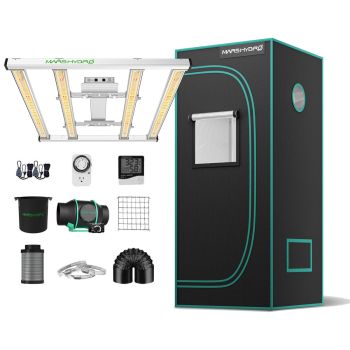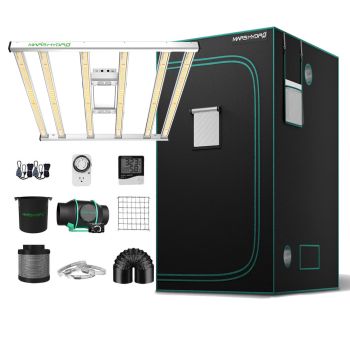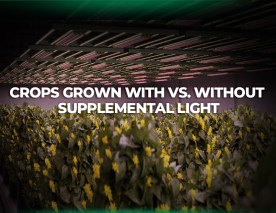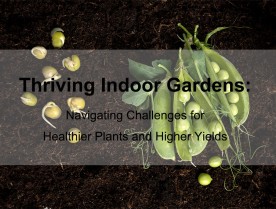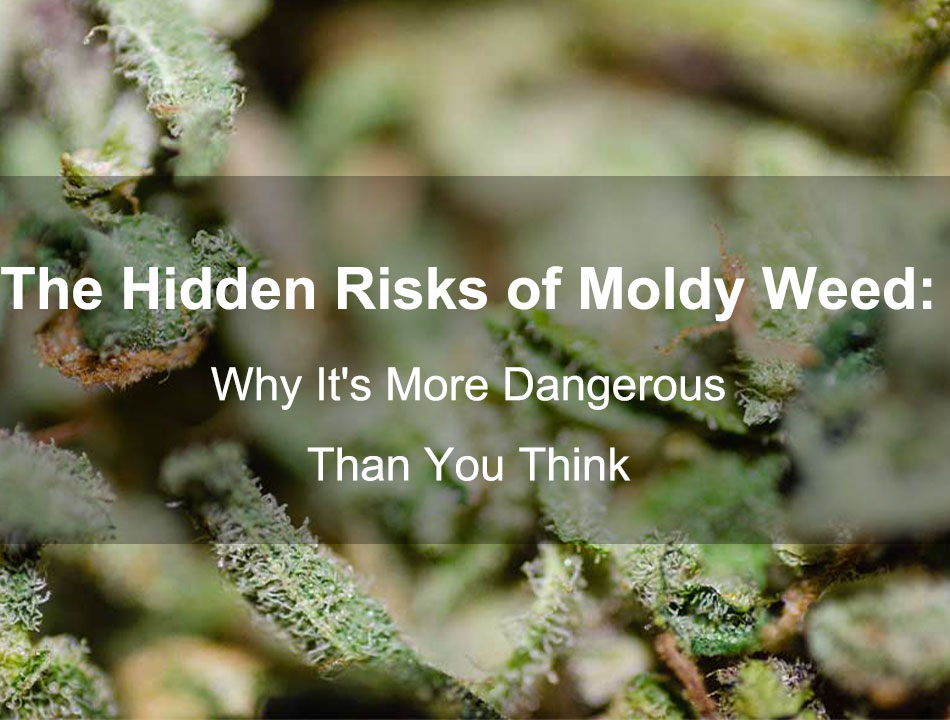
Have you ever picked up your stash and noticed something off? Maybe there's a strange white powder on the buds or a musty smell that doesn't quite smell like the fresh, herbal aroma you love. These could be telltale signs that your weed is moldy. But how can you be sure what you're seeing and smelling is indeed mold? And more importantly, what can you do about it?
In this blog, we'll guide you through the essentials of spotting moldy weed, understanding the risks it poses, and learning how to prevent it from ruining your stash. Whether you're a casual user or a medicinal consumer, knowing how to identify and manage mold on your weed is crucial for your health and enjoyment. So let’s dive in and clear the air about moldy weed!
Part 1: Identifying Moldy Weed
Moldy weed not only diminishes the aesthetic and sensory appeal of your buds but also poses serious health risks. Knowing how to spot mold can save you from potential health problems. Here’s a detailed look at how you can identify if your weed has succumbed to mold:
- Visual Signs: What does moldy weed look like? Often, mold on weed manifests as a white powdery substance or as dark spots on the buds. This is different from the shiny, sticky crystals (trichomes) that normally cover healthy weed buds. These visible mold signs can quickly spoil the entire bud and, if unnoticed, can affect your entire stash. Look for any unusual markings or changes in the bud's appearance that might indicate mold growth.
- Smell and Taste Test: Moldy weed typically gives off a musty or mildewy smell, which is distinctly different from the plant's natural aromatic profiles that can range from piney to citrusy. If your weed smells more like a damp basement than a fresh herb, it's likely got mold. Similarly, the taste of moldy weed is notably unpleasant and can deviate significantly from the typical flavors of weed. Instead of a clean, pure taste, moldy weed may taste harsh and leave an undesirable aftertaste.
5 Signs That Your Weed is Moldy
1. Discoloration: Any unusual coloration, such as brown or yellow patches on what is usually green weed buds, can be a sign of mold or bud rot.
2. Damp Smell: This is a red flag for mold presence. A healthy weed bud should smell fresh and inviting, not damp or stale.
3. White Powder: While this could sometimes be mistaken for kief, a dense accumulation of white powder might indicate the presence of white powdery mildew, a common fungal infection.
4. Slimy Buds: If your weed feels unusually sticky or slimy, mold spores might be affecting the resinous trichomes.
5. Bud Rot: This is a severe form of mold that can cause the weed buds to become spongy and fall apart easily, a definite sign of internal mold growth.
Identifying these signs early is crucial in preventing the consumption of moldy weed, which could lead to respiratory problems and other health issues. Always perform a thorough inspection of your weed products to ensure their quality and safety.
Part 2: The Risks of Moldy Weed
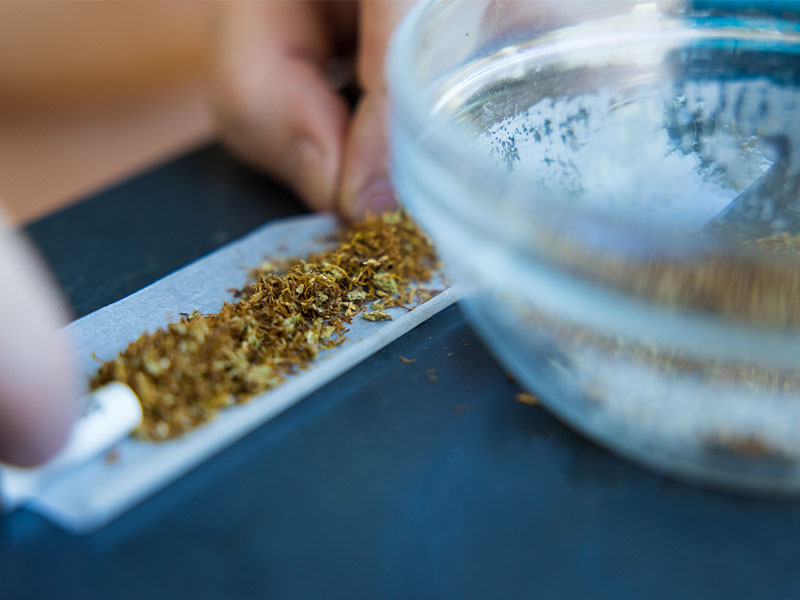
The presence of mold in weed poses significant health risks that should not be underestimated. When you smoke moldy weed, you are not just inhaling the active compounds of the plant, but also harmful mold spores that can adversely affect your health.
Respiratory Health Risks
Mold spores from moldy weed can lead to several respiratory problems, which might manifest as mild symptoms like coughing and sinus pain, or more severe conditions such as chest pain and serious lung infections. These risks are particularly heightened for individuals with weakened immune systems, who may find themselves susceptible to more severe fungal infections.
- Potential Health Risks of Smoking Moldy Weed:
Smoking weed contaminated with mold spores can introduce pathogens into your respiratory system. This can lead to a variety of symptoms including difficulty breathing, chest tightness, and in severe cases, chronic respiratory conditions. Mold exposure can trigger allergic reactions and exacerbate asthma, further compromising lung health.
- Cooking and Vaping with Moldy weed:
It's a common misconception that cooking or vaping moldy weed eliminates its risks. However, not all mold spores are destroyed by the heat from cooking or vaporizing. Certain types of mold, including the particularly dangerous aspergillus species, can withstand these temperatures and still pose health threats. Aspergillus is notorious for causing aspergillosis, a serious condition that can lead to lung infections and other systemic issues.
Broader Health Implications
Beyond immediate respiratory issues, smoking moldy weed can have broader health implications. Mold exposure is linked to long-term health problems, including immune system suppression and potentially serious infections. This is crucial for users to understand, as the prolonged inhalation of mold spores can lead to significant health deterioration over time.
Safety Precautions
For health's sake, it's vital to ensure that your weed products are mold-free before consumption. Whether smoking, cooking, or vaping, the use of moldy weed can result in health complications that far outweigh the intended benefits of the plant.
Part 3: Prevention and Solutions
Preventing mold growth is crucial for maintaining the safety and quality of your weed, whether it's growing plants or storing buds. Understanding and implementing the right strategies can significantly minimize the risks of mold development.
Proper Storage
Storing weed effectively is paramount to preventing mold growth:
- Airtight Containers: Use airtight containers to store your weed. Mason jars or specialty weed storage containers that offer a seal against air exposure can help maintain potency and prevent mold.
- Cool, Dark, Dry Places: Keep your weed in environments that are cool, dark, and dry. Excess heat or light can degrade your weed and promote the growth of mold. Avoid areas like damp basements or anywhere that might experience fluctuations in temperature and moisture.
- Avoid Direct Sunlight: Direct sunlight can heat up weed containers and create a micro-environment where humidity levels increase, leading to moisture content that can foster mold growth.
Maintaining Humidity Levels
Humidity control is essential for preventing mold in stored weed:
- Relative Humidity Levels: Keep the relative humidity (RH) of your storage area below 62%. This is particularly important because mold thrives in humid environments. Humidity control packets can be used to maintain optimal RH levels in your storage containers.
- Dry Air: Ensure that the air around your storage area is dry. Using dehumidifiers in larger storage areas or rooms where weed is kept can help maintain the right dry conditions and prevent mold from growing.
Benefits of Indoor Growing
Growing weed indoors provides significant advantages in controlling environmental conditions:
- Controlled Humidity and Moisture: Indoor growing allows for comprehensive management of humidity and moisture levels. Systems like automated dehumidifiers and air conditioners can be fine-tuned to maintain the ideal environmental conditions that discourage mold growth.
- Avoiding External Contaminants: Indoor environments help protect weed plants from external contaminants and airborne spores that could introduce mold. By growing indoors, you can create a sealed environment that minimizes the risk of mold spores entering from the outside.
- Optimized Growing Conditions: Indoor cultivation enables the grower to control all aspects of the environmental conditions, from temperature to light cycles and ventilation. This level of control is crucial in preventing conditions that favor mold development, ensuring the health and quality of the weed plants.
By following these preventive measures, weed users and growers can effectively manage the risk of mold and maintain the quality and safety of their weed products. Whether you're storing your weed or cultivating it, understanding the importance of environmental control and proper storage will help you avoid the pitfalls of mold growth and enjoy a safer weed experience.
Part 4: Can Moldy Weed Be Salvaged?

When faced with moldy weed, the primary concern for any user should be safety. Mold presence on weed is not just a minor nuisance; it poses serious health risks, especially when smoked or ingested.
Is It Safe?
It is widely recommended to avoid using moldy weed due to the significant health risks it presents. Smoking moldy weed can introduce harmful mold spores into the respiratory system, potentially leading to severe health complications, including respiratory system damage and fungal infections. These health concerns are particularly acute for individuals with compromised immune systems, asthma, or other respiratory conditions.
- Health Risks: The risks include allergic reactions, asthma attacks, and even more severe conditions like lung infections or fungal pneumonia. Given these potential health risks, the safest course of action is to avoid using moldy weed altogether.
Salvaging Techniques
While there are methods touted to potentially salvage moldy weed, the safety and effectiveness of these techniques are questionable:
- Decarboxylation: Some suggest that decarboxylation, a process that involves heating weed to activate its psychoactive compounds, might also kill some types of mold spores. However, this method does not remove all toxins produced by mold, such as mycotoxins, which can remain in the weed even after heat treatment.
- Safety Concerns: The key issue with trying to salvage moldy weed through heating or other methods is that not all mold spores and toxins are eliminated. Aspergillus, a common mold found on weed, can produce spores that are heat-resistant and may survive processes like baking or vaping.
The Common Sense Approach
Considering the health risks and the potential for ineffective removal of mold and toxins, the most sensible approach is to discard any moldy weed products. No method of salvaging moldy weed guarantees complete removal of all harmful elements, and the risks involved with trying to use such weed far outweigh the potential benefits.
- Proper Disposal: Ensure that moldy weed is disposed of in a way that it cannot be accidentally used or consumed by others. This protects not just your health but also the health of others around you.
In conclusion, while it's disheartening to dispose of weed that you've invested in, the risks associated with trying to salvage moldy weed make it clear that for the sake of your health and safety, disposal is the best option. Always prioritize health over salvage and stay informed about the best practices for preventing mold in your weed stash.
Conclusion
Understanding how to identify and prevent mold on your weed is not just about preserving the quality of your experience—it's a crucial step in protecting your health.
Smart consumer practices are not just about getting the best value—they're about ensuring safety and quality in every puff.





